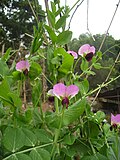Top Qs
Timeline
Chat
Perspective
Snow pea
Type of edible-pod pea From Wikipedia, the free encyclopedia
Remove ads
The snow pea (British English: mangetout[2][3]) is an edible-pod pea with flat pods and thin pod walls unlike snap pea pods, which are round with thick walls.[4] It is eaten whole, with both the seeds and the pod, while still unripened.
Remove ads
Names
The common name snow pea seems to be a misnomer as the planting season of this pea is no earlier than that of other peas. Another common name, Chinese pea, is probably related to its prominence in Chinese dishes served in the West.[5]
Snow peas and snap peas both belong to Macrocarpon Group,[5][6][1][7] a cultivar group based on the variety Pisum sativum var. macrocarpum Ser.. The original 1825 publication described the variety as having very compressed non-leathery edible pods.[8]
The scientific name Pisum sativum var. saccharatum Ser. is often misused for snow peas. The variety under this name was described as having sub-leathery and compressed-terete pods and the French name petit pois (which is the French term for tender garden pea).[8] The description is inconsistent with the appearance of snow peas, and therefore botanists have replaced this name with Pisum sativum var. macrocarpum.[9] Austrian scientist and monk Gregor Mendel used peas which he called Pisum saccharatum in his famous experiments demonstrating the heritable nature of specific traits, and this Latin name might not refer to the same varieties identified with modern snow peas.[10]
Remove ads
Composition
Nutrition
Remove ads
Uses
Culinary

Snow peas, along with snap peas and unlike field and garden peas, are notable for having edible pods that lack inedible fiber[13] (in the form of "parchment", a fibrous layer found in the inner pod rich in lignin[14]) in the pod walls. Snow peas have the thinner walls of the two edible pod variants. Two recessive genes known as p and v are responsible for this trait.[13] p is responsible for reducing the sclerenchymatous membrane on the inner pod wall, while v reduces pod wall thickness (n is a gene that thickens pod walls in snap peas).[15]
Pea shoots (Chinese: 豆苗; pinyin: dòu miáo) are the stems and leaves of the immature plant, used as a vegetable in Chinese cooking.[16] They are commonly stir-fried with garlic and sometimes combined with crab or other shellfish.[17]
Nitrogen fixers
As with most legumes, snow peas host beneficial bacteria, rhizobia, in their root nodules, which fix nitrogen in the soil—this is called a mutualistic relationship—and are therefore a useful companion plant, especially useful to grow intercropped with green, leafy vegetables that benefit from high nitrogen content in their soil.[18]
Cultivation
Snow peas can be grown in open fields during cool seasons and can thus be cultivated during winter and spring seasons.[15]
Storage
Storage of the pea with films of polymethylpentene at a temperature of 5 °C (41 °F) and controlled atmosphere with a concentration of oxygen and carbon dioxide of 5 kPa augments the shelf life, internal and external characteristics of the plant.[19]
Gallery
- Snow pea flowers
- Sautéed snow pea shoots, a popular dish in Chinese cuisine
See also
References
Wikiwand - on
Seamless Wikipedia browsing. On steroids.
Remove ads




